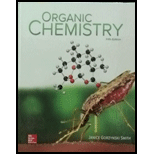
Concept explainers
You have a sample of a compound of molecular formula
by two groups,
benzene isomer corresponds to these

Want to see the full answer?
Check out a sample textbook solution
Chapter 17 Solutions
ORGANIC CHEMISTRY-W/ACCESS >CUSTOM<
- The 13C-NMR spectrum of 3-methyl-2-butanol shows signals at 17.88 (CH3), 18.16 (CH3), 20.01 (CH3), 35.04 (carbon-3), and 72.75 (carbon-2). Account for the fact that each methyl group in this molecule gives a different signal.arrow_forwardThe following 1H NMR peaks were recorded on a spectrometer operating at 200 MHz. Convert each into δ units. (a) CHCl3; 1454 Hz (b) CH3Cl; 610 Hz (c) CH3OH; 693 Hz (d) CH2Cl2; 1060 Hzarrow_forward3-Bromo-1-phenyl-1-propene shows a complex NMR spectrum in which the vinylic proton at C2 is coupled with both the C1 vinylic proton (J = 16 Hz) and the C3 methylene protons (J = 8 Hz). Draw a tree diagram for the C2 proton signal, and account for the fact that a five-line multiplet is observed.arrow_forward
- 3-Methyl-2-butanol has five signals in its 13C NMR spectrum at 17.90, 18.15, 20.00, 35.05, and 72.75 . Why are the two methyl groups attached to C3 nonequivalent? Making a molecular model should be helpful.arrow_forwardAssign as many resonances as you can to specific carbon atoms in the 13C NMR spectrum of ethyl benzoate.arrow_forwardPropose structures for compounds that fit the following descriptions: (a) A hydrocarbon with seven lines in its 13C NMR spectrum (b) A six-carbon compound with only five lines in its 13C NMR spectrum (c) A four-carbon compound with three lines in its 13C NMR spectrumarrow_forward
- When the 1HNMR spectrum of an alcohol is run in dimethylsulfoxide (DMSO) solvent rather than in chloroform, exchange of the Ο-H proton is slow and spin-spin splitting is seen between the Ο-H proton and C-H protons on the adjacent carbon. What spin multiplicities would you expect for the hydroxyl protons in the following alcohols? (a) 2-Methyl-2-propanol (b) Cyclohexanol (c) Ethanol (d) 2-Propanol (e) Cholesterol (f) 1-Methylcyclohexanolarrow_forward1-(4-methoxyphenyl)-methyl propan-1-ol. Draw a Newman projection along C(1)-C(2), with the HO group attached to C(1). Are the two methyl groups equivalent? What evidence do you find from the NMR spectrum to support your conclusion?arrow_forwardThe compound has a molecular formula of C5H10O and the following 13C spectrum. A proton NMR was measured, but the data was lost except for the fact that it showed three distinct signals: a singlet, a doublet, and a septet, all of which appear between 0 and 3 ppm. Identify the compound, and draw its 1H NMR.arrow_forward
- The intensities of peaks at 69 m/z, 70 m/z, and 71 m/z are 1.2, 31.2, and 1.7, respectively. How many carbons does the compound have?arrow_forwardThese are four alcohols with the formula C4H10O. One of them produced this C-NMR spectrum, which alcohol did that and what carbons correspond with what peaks?arrow_forwardThe molecular formula of an unknown compound is C7H13BrO2, The strong peak at 1750 cm^-1 The proton NMR data is, 1.2d(6H, d), 4.2d(1H, t), 2.2d(2H, quintet), 4.93d(1H, septet),1.08d(3H,t).What is the name of the unknown compound? Isopropyl 2-bromobutanoate 1-bromopropyl isobutyrate ethyl 2-bromo-3-methylbutanoate 1-bromoethyl 3-methylbutanoatearrow_forward

 Organic ChemistryChemistryISBN:9781305580350Author:William H. Brown, Brent L. Iverson, Eric Anslyn, Christopher S. FootePublisher:Cengage Learning
Organic ChemistryChemistryISBN:9781305580350Author:William H. Brown, Brent L. Iverson, Eric Anslyn, Christopher S. FootePublisher:Cengage Learning Principles of Instrumental AnalysisChemistryISBN:9781305577213Author:Douglas A. Skoog, F. James Holler, Stanley R. CrouchPublisher:Cengage Learning
Principles of Instrumental AnalysisChemistryISBN:9781305577213Author:Douglas A. Skoog, F. James Holler, Stanley R. CrouchPublisher:Cengage Learning


